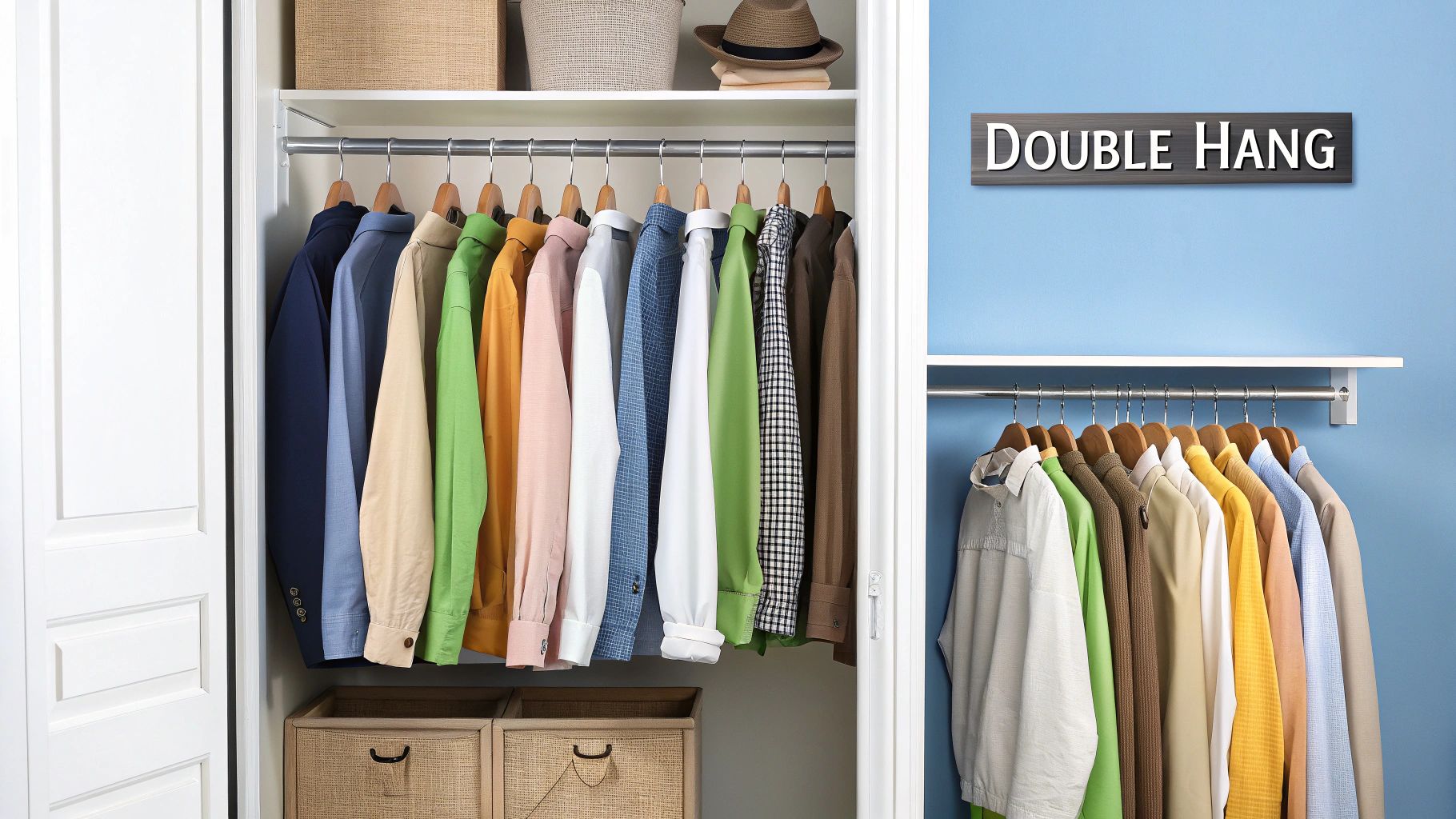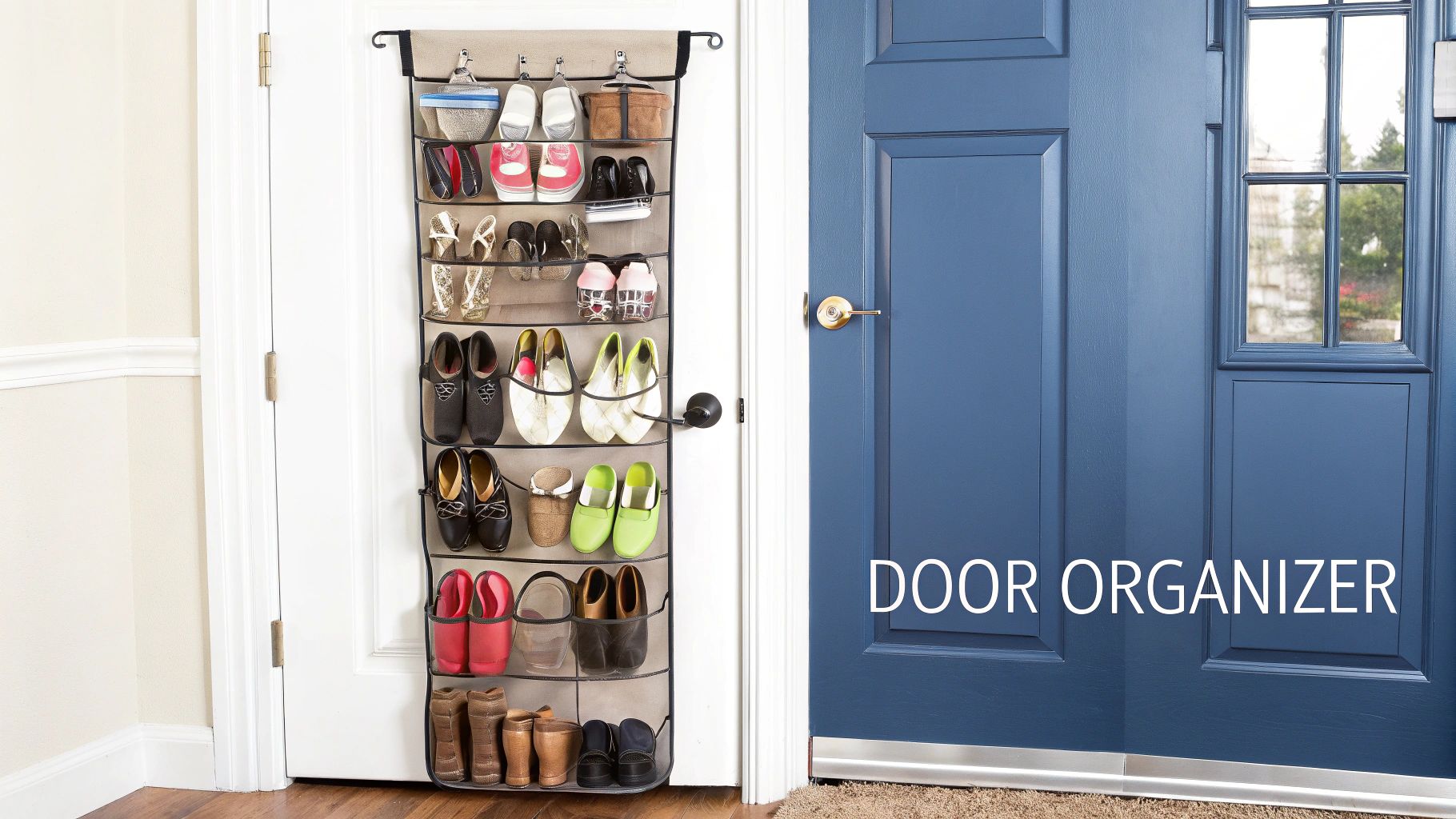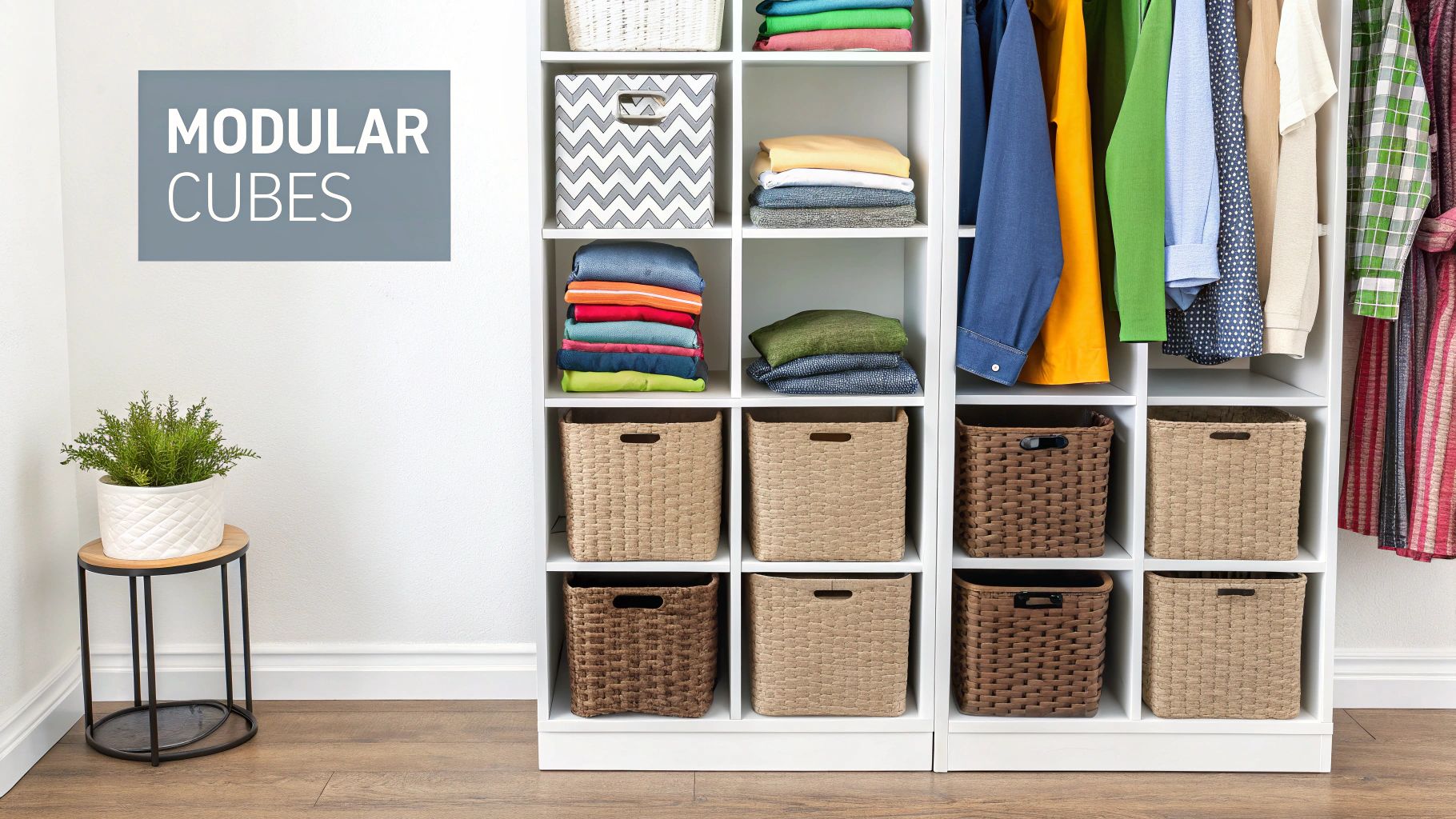Top Closet Organization Ideas Small Space Experts Recommend

Struggling with a closet that's bursting at the seams? It's a common battle, especially where every square inch counts. The challenge isn't a lack of space, but a need for smarter closet organization. This guide offers specific, actionable closet organization ideas for small spaces that create a functional, streamlined wardrobe. We're here to help you transform that cramped, chaotic area into a model of efficiency.
This listicle provides a curated roundup of practical solutions designed to maximize every vertical and horizontal inch. We'll explore innovative techniques and tools, from implementing vertical double-hang systems and cascading hangers to leveraging modular cube storage and over-the-door solutions. You will learn how to rethink your closet's layout, reclaim unused areas, and implement systems that make your daily routine smoother.
Prepare to unlock your closet's hidden potential with these detailed organizational tips. Our goal is to make finding the perfect outfit an effortless part of your day, proving that even the most compact closet can become an organized, accessible, and calm space. Let's get organizing.
1. Vertical Double-Hang System
One of the most effective closet organization ideas for a small space is to harness unused vertical real estate. A vertical double-hang system transforms a single closet rod into two distinct hanging levels, instantly doubling your storage capacity for shorter garments. This approach is perfect for closets with a single rod placed too high, leaving a vast, empty space below.
By installing a second rod, you can dedicate separate tiers for different types of clothing. This system is a cornerstone of professional closet design, frequently implemented to maximize every square inch.

How to Implement a Double-Hang System
Implementing this system is straightforward with adjustable, off-the-shelf products. Brands like ClosetMaid offer modular systems that are ideal for renters or those who prefer not to make permanent installations. In a typical setup, the top rod is positioned around 80-82 inches from the floor, and the bottom rod is placed at about 40 inches.
Pro Tip: This 40-inch spacing is the key. It provides just enough room for folded pants, skirts, and shirts to hang freely without dragging, making it an incredibly efficient use of closet space.
For a deeper dive into setting up this system, see the video below:
Actionable Tips for Success
To make the most of your new closet setup, follow these practical tips:
- Organize by Type: Place shirts and blouses on the top rod and folded pants or skirts on the bottom rod. This creates a visually clean and logical arrangement.
- Prioritize Accessibility: Keep your most frequently worn items on the more accessible level, which for most people is the top rod.
- Measure First: Before installing, measure your longest items (like folded-over pants) to ensure you leave adequate vertical clearance. A minimum of 40 inches per tier is a reliable standard.
- Use Slim Hangers: To further maximize your newly doubled space, use uniform, slim-profile hangers. This allows you to fit more items on each rod without creating a cramped, bulky look.
2. Cascading Hangers and Space-Saving Hangers
Another powerful closet organization idea for a small space involves using hangers that work vertically. Cascading or space-saving hangers are designed to consolidate multiple garments into a fraction of the horizontal rod space, making them an essential tool for any packed closet. These innovative hangers either connect to one another vertically or feature multiple tiers on a single hanger.
This method allows you to group outfits or similar items together, creating a compact, organized system that frees up significant room on your closet rod. Championed by professional organizers, this vertical storage strategy is a game-changer for tiny closets.

How to Implement Cascading Hangers
Integrating this system is as simple as swapping out your traditional hangers for specialized ones. Brands like MORALVE have perfected designs that allow you to hang up to five garments in the space of one. These hangers often feature a hook that can be dropped down, which lets the attached garments hang vertically and neatly compress. This is an immediate and impactful way to reclaim closet real estate.
Pro Tip: Use cascading hangers for clothing categories you have in multiples, like work blouses, camisoles, or even lightweight jackets. Grouping them vertically not only saves space but also makes it easier to see all your options at a glance.
For additional clever ways to manage your hangers and optimize space, explore different techniques for storing hangers on moralve.com.
Actionable Tips for Success
To effectively use cascading hangers and maximize your closet space, consider these tips:
- Group Like Items: Organize garments by type or color on each cascading hanger. For example, dedicate one for work shirts and another for casual tops.
- Balance the Weight: Distribute clothing evenly to prevent the hanger from tilting and ensure your clothes hang properly without excessive wrinkling.
- Check Rod Strength: Before loading up, confirm your closet rod is sturdy enough to support the concentrated weight of multiple garments on a single hook.
- Prioritize Seasonal Items: Use cascading hangers for off-season clothing. This allows you to keep them accessible but compactly stored, freeing up prime real estate for your current wardrobe.
3. Over-the-Door Storage Solutions
One of the most overlooked yet valuable spaces in a small closet is the back of the door. Over-the-door storage solutions are a brilliant closet organization idea for a small space because they reclaim this vertical area without consuming any floor or shelf space. These systems, ranging from pocket organizers to hanging racks, turn your door into a powerhouse of organization for shoes, accessories, and other miscellaneous items.
This strategy allows you to store items neatly, keeping them visible and accessible while freeing up primary storage zones for bulkier clothing.

How to Implement Over-the-Door Storage
Implementation is as simple as hanging a unit over your door; no tools are required for most models. You can find a variety of options, from popular 24-pocket shoe organizers to versatile multi-hook racks. These systems are designed to fit standard interior doors and provide immediate, functional storage.
Pro Tip: Look for organizers with clear or mesh pockets. This design feature allows you to see the contents at a glance, eliminating the need to search through every compartment and saving you valuable time.
For a great example of how these organizers can transform a space, check out the video below:
Actionable Tips for Success
To get the most out of your over-the-door system, consider these practical tips:
- Group Like Items: Designate specific pockets or sections for categories like scarves, belts, or hats. This creates an intuitive system where everything has a designated home.
- Balance the Weight: Place heavier items like shoes or bulky accessories in the lower pockets to ensure the organizer hangs properly and doesn't strain the door.
- Mind the Swing: Before loading it up, check your door's swing clearance. Ensure the organizer won't bump into walls or other furniture, which could limit access.
- Think Beyond Shoes: While often marketed for footwear, these organizers are perfect for rolled-up t-shirts, socks, clutches, and beauty products, making them a versatile tool in any small closet.
4. Modular Cube Storage Systems
When floor space is limited, modular cube storage systems offer unparalleled flexibility. These systems consist of interlocking cubes that can be stacked and arranged to perfectly fit your closet's unique dimensions, making them one of the most adaptable closet organization ideas for a small space. They create custom-built solutions without the custom price tag, ideal for storing folded clothes, shoes, bags, and accessories.
The beauty of these systems lies in their ability to grow and change with your needs, allowing you to reconfigure them as your wardrobe evolves.

How to Implement a Modular Cube System
Implementing a cube storage system is a simple process. Brands like SONGMICS and ClosetMaid offer lightweight, interlocking panel systems that snap together in minutes. You can start by building a small tower to fit under hanging clothes or a wider, shorter unit to act as a shoe rack on the closet floor.
Pro Tip: Combine open cubes with fabric or wicker bins. Use open cubes for displaying items like handbags and shoes, and use bins to conceal smaller items like socks or scarves. This creates a clean, visually balanced look.
These systems are a key component in many creative storage setups. To see more ways they can be integrated, you can explore various small closet storage solutions.
Actionable Tips for Success
To get the most out of your modular cube storage, consider these practical tips:
- Build Vertically: Maximize vertical space by stacking cubes as high as your closet allows, drawing the eye upward and freeing up valuable floor area.
- Assign a Purpose: Designate specific cubes for different categories, such as one for sweaters, another for jeans, and one for workout gear, to maintain order.
- Prioritize Accessibility: Place your most-used items in cubes at eye level for easy access. Reserve higher or lower cubes for less frequently needed items.
- Label Your Bins: If using fabric bins, attach labels to the front so you can quickly identify the contents without having to pull each one out.
5. Vacuum Storage Bags and Compression Solutions
One of the most transformative closet organization ideas for a small space is to reclaim volume taken up by bulky items. Vacuum storage bags allow you to significantly reduce the size of seasonal clothing, bedding, and puffy jackets, shrinking their volume by up to 80%. This method is a game-changer for anyone struggling with limited shelf or floor space.
By removing air from the bags, soft goods are compressed into a dense, flat, and stackable package. Solutions like SpaceSaver and HIBAG vacuum bags have become essential tools for seasonal clothing rotation and dorm room organization.
How to Implement Vacuum Storage
Using compression bags is simple: fold your items, place them inside the bag, seal it, and then use a standard vacuum cleaner hose to suck out all the air through the valve. The result is a compact, protected block that can be easily stored on a high shelf or at the back of the closet, freeing up prime real estate for in-season apparel.
Pro Tip: Before sealing, fold items as flat and uniformly as possible. This minimizes deep-set wrinkles when you unpack them later and allows you to create a more evenly shaped, stackable package for efficient storage.
For a clear demonstration on how to use these bags effectively, check out this quick tutorial:
Actionable Tips for Success
To get the most out of this space-saving method, consider these practical tips:
- Designate for Deep Storage: This solution is best for out-of-season items you won't need for several months, such as winter parkas or heavy blankets.
- Label Everything: Use a permanent marker or adhesive label to clearly mark the contents of each bag (e.g., "Winter Sweaters") to avoid having to unseal them to find something.
- Avoid Overfilling: Don't stuff bags past the indicated "fill line." Overfilling can compromise the seal and lead to the bag slowly re-inflating over time.
- Check Seals Periodically: Every few months, give the bags a quick check to ensure they are still fully compressed. A faulty seal can be easily fixed, but it's best to catch it early.
6. Pull-Out Drawers and Sliding Organizers
Deep closets in a small space often create more problems than they solve, as items get lost in the dark, unreachable back. Pull-out drawers and sliding organizers are a game-changing closet organization idea that transforms this wasted depth into fully accessible, functional storage. By bringing the back of the closet to you, these systems eliminate frustrating dead space.
This approach is a staple in high-end closet design. Sliding mechanisms allow you to see and reach everything you own, from folded sweaters to accessories, without having to dig through piles.
How to Implement Sliding Organizers
You can integrate pull-out drawers through custom installations or with ready-made modular systems. Brands like Rev-A-Shelf offer wire baskets that can be retrofitted into existing cabinetry, while IKEA’s KOMPLEMENT series provides pull-out trays and drawers designed for their wardrobes. These solutions make it easy to create a more organized and efficient closet layout.
Pro Tip: Install organizers at different heights to create dedicated zones. Place pull-out trays for shoes near the floor and drawers for socks, underwear, and accessories at waist level for effortless daily access.
Actionable Tips for Success
To get the most out of your pull-out drawers, consider these practical tips:
- Measure with Precision: Before buying, carefully measure the interior width, depth, and height of your closet. Account for hinges or other obstructions that might interfere with the sliding mechanism.
- Check Weight Capacity: Be mindful of the drawer’s weight limit. Heavier items like denim or bulky sweaters should be stored in drawers designed to handle the load.
- Organize with Dividers: Use drawer dividers to compartmentalize smaller items like socks, belts, and ties. This prevents them from shifting and becoming jumbled.
- Prioritize Accessibility: Use drawers for frequently accessed items. Their convenience is best leveraged for things you use daily, making your morning routine much smoother.
7. Ceiling-to-Floor Maximization with Adjustable Shelving
One of the most transformative closet organization ideas for a small space is to fully utilize the entire vertical span from floor to ceiling. An adjustable shelving system achieves this by installing vertical tracks that allow you to position shelves exactly where you need them, adapting to your belongings and eliminating wasted space. This approach is ideal for closets with high ceilings.
By extending storage all the way to the ceiling, you create designated zones for different categories of items. It offers a custom-fit solution without the cost of a full custom build-out, providing unparalleled flexibility.
How to Implement Adjustable Shelving
Installing a track-based system is a scalable project. Brands like ClosetMaid (ShelfTrack) and Rubbermaid (Configurations) offer user-friendly kits available at most home improvement stores. These systems involve mounting vertical standards directly onto the wall, into which brackets and shelves can be easily clipped and adjusted.
Pro Tip: When planning your layout, leave minimal vertical space above your items. Position a shelf just an inch or two above a stack of sweaters or a row of shoes. This hyper-efficient spacing is the key to maximizing every inch.
Actionable Tips for Success
To get the most out of your floor-to-ceiling system, apply these practical strategies:
- Zone Your Storage: Use the highest, least accessible shelves for out-of-season clothing or luggage. Keep everyday essentials at eye level for easy access.
- Plan Shelf Spacing: Before installing, measure the height of items you plan to store, like shoe boxes or storage bins, to customize the spacing.
- Incorporate Lighting: High shelves can be dark. Install battery-operated, motion-sensor LED lights under shelves to illuminate the entire closet space.
- Keep a Stool Handy: Store a small, foldable step stool nearby to safely and easily reach items on the top shelves. For more tips on expanding your storage, check out these strategies on how to make a small closet bigger.
8. Multi-Functional Storage Ottomans and Benches
One of the most clever closet organization ideas for a small space is to introduce furniture that serves a dual purpose. A multi-functional storage ottoman or bench acts as both concealed storage and practical seating, making it an invaluable addition near your closet. This approach adds storage capacity without sacrificing precious floor space to single-use items.
These pieces are designed to be both stylish and efficient, providing a home for bulky items like extra bedding, seasonal accessories, or shoes. Multi-functional solutions help create clutter-free, functional living areas.
How to Implement a Storage Ottoman or Bench
Integrating this piece into your space is as simple as choosing a style that complements your decor and meets your storage needs. For instance, a storage ottoman is a popular choice for studio apartments to discreetly store shoes, while a storage bench can organize items in a child’s room with a tiny closet. The key is to select a piece that fits the scale of your room.
Pro Tip: Look for ottomans with built-in dividers or compartments. These internal organizers are perfect for separating pairs of shoes or sorting handbags, preventing the inside from becoming a disorganized jumble.
For a great example of how to use a storage ottoman in a small bedroom, check out the video below:
Actionable Tips for Success
To get the most out of your multi-functional furniture, consider these practical tips:
- Position Strategically: Place your bench or ottoman where it can serve as a convenient dressing seat, making it easier to put on shoes.
- Store Daily Items: Use it to store items you access frequently but want out of sight, such as your gym bag, daily-wear shoes, or scarves and hats.
- Consider Mobility: If you need to move the piece often, choose a lightweight model or one with casters for easy repositioning.
- Maintain Cleanliness: Opt for furniture with a durable, easy-to-clean material like faux leather to keep it looking fresh.
8-Option Closet Organization Comparison
| Storage Solution | Implementation Complexity 🔄 | Resource Requirements ⚡ | Expected Outcomes 📊 | Ideal Use Cases 💡 | Key Advantages ⭐ |
|---|---|---|---|---|---|
| Vertical Double-Hang System | Low - easy installation and adjust | Minimal investment, adjustable rods | Doubles hanging capacity for short garments | Studio apartments, shared bedrooms, narrow closets with high ceilings | Cost-effective, space-maximizing, adjustable |
| Cascading & Space-Saving Hangers | Low - simple product setup | Low cost, multi-tier or cascading hangers | Up to 500% increased hanging capacity | Small apartments, RVs, tiny homes | Highly efficient use of rod space, inexpensive |
| Over-the-Door Storage Solutions | Very low - no drill, hook installation | Minimal materials, over-door organizers | Adds storage without taking floor or shelf space | Urban apartments, dorms, anywhere unused door space exists | Quick install, visible organization |
| Modular Cube Storage Systems | Moderate - assembly required | Moderate cost, configurable cubes | Customizable flexible storage for varied items | Closets needing adaptable storage, growing families | Highly customizable, scalable, defined spaces |
| Vacuum Storage Bags & Compression | Low - just usage of bags and pump | Low cost, bags and vacuum pump | Reduces volume up to 80%, protects seasonal items | Seasonal clothing, bulky bedding, limited shelf space | Significant space reduction, item protection |
| Pull-Out Drawers & Sliding Organizers | Moderate to high - may need professional install | Higher cost, sliding hardware and drawer materials | Full accessibility to deep closet spaces | Deep closets, frequently accessed small items | Maximizes depth, professional look |
| Ceiling-to-Floor Adjustable Shelving | High - planning and precise install | Higher upfront cost, shelving tracks and brackets | Maximal vertical space utilization | Closets with tall ceilings, long-term adaptable storage | Fully utilizes vertical space, highly adaptable |
| Multi-Functional Storage Ottomans | Low to moderate - furniture purchase | Moderate cost, floor space required | Extra seating plus concealed storage | Bedroom corners, just outside closet, small living spaces | Dual-purpose furniture, adds decor value |
Your Blueprint for a Perfectly Organized Small Closet
Transforming a cramped, chaotic closet into a streamlined, functional space is entirely within your reach. The solution isn't wishing for more square footage but strategically organizing the space you already have. The journey from clutter to clarity is built on clever choices that reclaim every underutilized inch. By embracing these principles, you're not just organizing clothes; you're engineering a system that simplifies your life.
The core takeaway from these diverse closet organization ideas for a small space is a shift in perspective. Instead of seeing limitations, you can now see potential. Vertical space, once ignored, becomes prime real estate with double-hang systems and floor-to-ceiling shelving. The backs of doors transform into powerful storage hubs. Even the air within your closet can be compressed with vacuum-sealed bags, creating space you never knew existed.
Key Principles for Lasting Organization
To ensure your efforts create a lasting change, let's distill the most impactful strategies into a clear action plan. These are the pillars of small closet mastery:
- Think Vertically: The most common mistake is focusing only on horizontal space. Implementing double-hanging rods, adjustable shelving that reaches the ceiling, and over-the-door organizers immediately multiplies your storage capacity.
- Decant and Contain: Just as you would in a kitchen, "decant" your belongings into purpose-built containers. Modular cubes, pull-out drawers, and clear bins prevent visual clutter and make it effortless to find what you need.
- Invest in Smart Tools: The right tools act as force multipliers. Cascading hangers are a perfect example of a small investment that delivers a massive return in reclaimed rod space. Similarly, a multi-functional storage ottoman adds seating and concealed storage.
Your Actionable Next Steps
Feeling motivated? The best way to begin is by choosing one or two high-impact strategies to implement. Start with a thorough decluttering session to purge items you no longer need, creating a clean slate. Next, measure your space and identify your biggest pain point. Is it a tangled mess of hangers? Tackle that with uniform, space-saving hangers. Are your shoes in a chaotic pile? An over-the-door organizer or a modular cube system will provide an immediate improvement.
By implementing these closet organization ideas for a small space, you create a positive feedback loop. Each small victory builds confidence and makes the next step easier. A well-organized closet is a functional system that supports your daily routine, protects your wardrobe investment, and brings a sense of calm to your personal environment.
Ready to take the single most impactful step toward a decluttered closet? Elevate your organization with space-saving hangers from MORALVE. Their innovative cascading designs are specifically engineered to maximize vertical rod space, allowing you to store more while seeing everything clearly. Explore the collection at MORALVE and discover the perfect foundation for your newly organized wardrobe.


Leave a comment